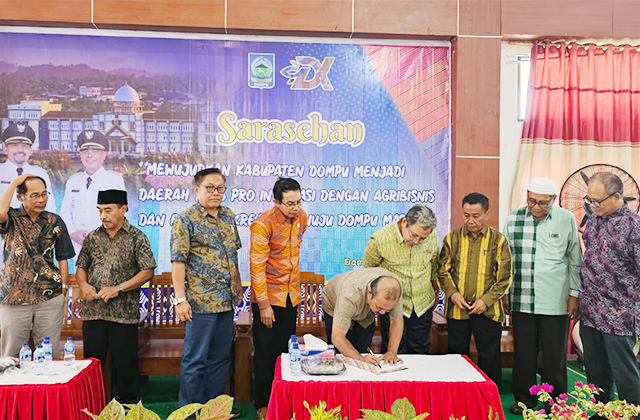CESFARMS Unram and Dompu Regency Government Hold JARAPASAKA Programme Assistance Workshop and Cooperation Plan Development

Mataram, University of Mataram – The Center for Sustainable Farm Systems University of Mataram (CESFARMS Unram) held an advisory session on the JARAPASAKA programme and the preparation of a cooperation plan between the Dompu Regency Government and CESFARMS Unram. The workshop was held in the Pendopo Hall of the Dompu Regent’s Office on 25-26 June 2024, with the topic “Realising Dompu Regency as a Pro-Investment Region with Agribusiness and Creative Economy Towards Dompu Mashur”.
On this occasion, attended by the Head of LPPM Unram, Prof. Dr. Ir. Sukartono, M.Agr. accompanied by Prof. Ir. Yusuf Akhyar Sutaryono, Ph.D.; Ir. I Gusti Lanang Parta Tanaya, Ph.D.; Prof. Muhammad Junaedi; and Naufal Armanditya, M.Si. The Head of Bappeda and Litbang of Dompu Regency, Drs. H. Gaziamansyuri, MM, who represented the Regent of Dompu, was also present.
Starting the event, Prof. Sukartono, Head of LPPM Unram and CESFARMS Expert Team explained, “The importance of implementing sustainable conservation agriculture such as Agroforestry in Dompu to prevent land degradation that continues to occur today.”
Agroforestry is a collective name for land use systems and technologies, which are planned to be implemented on one unit of land by combining woody plants (trees, shrubs, palms, bamboo etc.) with agricultural crops and/or animals (livestock), which are carried out at the same time or in rotation so that ecological and economic interactions between the various components are formed.
Agroforestry systems have a combination of various types of plants, so it is necessary to know the potential of land or land class/ability for certain types of land use (plant types and management levels). For this reason, a design is needed which is a process of formulating, spatially and temporally, land use and seeing the best possibilities from an economic, environmental and social perspective.
Continuing the land conservation presentation, Prof. Yusuf Akhyar Sutaryono, Ph.D on this occasion said, “The advantages of lamtoro taramba as a financially profitable animal feed that can be developed around farmers’ homes and can also be used as a land conservation crop. The availability of alternative resources and the suitability of the climate open potential opportunities for processed livestock products business to be developed in Dompu.”
The advantages of using agroforestry systems are diversified income, energy conservation, increased productivity, increased carbon stocks, increased biodiversity, and can reduce the impact of climate change through carbon sequestration. Four-Dimensional Agroforestry (4D Agroforestry) is an effort to optimise land by integrating forestry crops, agriculture and livestock, and considering 4 dimensions to increase the income of the people of Dompu Regency in the future.
The final presentation was delivered by Ir. I Gusti Lanang Parta Tanaya, Ph.D., “Increasing the added value of agricultural products through the downstream process is a demanded condition that must be carried out by all stakeholders in the agricultural sector.”
In addition to the application of agroforestry systems, Dompu Regency also has great opportunities in the development of fish farming in tarpaulin ponds due to the sandy soil conditions because in sandy soil the water will continue to decrease because it seeps directly into the soil. The condition of the coastal area and the lack of freshwater will allow tarpaulin pond farming to contribute significantly to the economy of the people in this area.
Another advantage of tarpaulin pond farming is that the water temperature in tarpaulin ponds is more stable. In addition, fish from tarpaulin farming do not smell like mud, which is relatively more favourable to consumers. Another thing is that in fish farming carried out in tarpaulin ponds, fish waste and feed residue that accumulate at the bottom of the pond are easier to clean by vacuuming (shift pond). In addition, it is also easier to harvest fish at harvest time. Thus, farmers need to accelerate fish production in a short time but using safe methods.
Prof. Muhammad Junaedi continued, “Freshwater fish farming techniques in tarpaulin ponds are a great opportunity to be developed in Dompu Regency.” He also explained in detail the best ways to cultivate catfish and tilapia in tarpaulin ponds based on his research results.
The event did not only provide academic knowledge but also a demonstration of fish farming in tarpaulin ponds and strategic steps in improving fish rearing businesses that are profitable both in the long and short term.
The workshop resulted in several recommendations for the continued implementation of the JARAPASAKA programme which will be followed up in the JARAPASAKA OPD work programme in 2025, while still expecting assistance from Unram, especially CESFARMS. The Dompu Regency Government expressed its gratitude and highest appreciation for the assistance of Unram’s CESFARMS expert team in supporting the progress of Dompu’s agricultural development.
